On May 5, I posted a video titled, “California avocado superbloom 2023.” In it I showed a large Gwen avocado tree that looked like a massive yellow ball of flowers, and I gave my thoughts on why this tree and some others I had seen around Southern California were having such an intense season of flowering.
And I wondered whether the pollination of these numerous flowers would follow. If you don’t mind me quoting myself: “I suspect the fruitset won’t be quite as spectacular as the amount of bloom.”
So what happened? How has the pollination of California avocado trees turned out this spring of 2023? It is here in August that we can begin to take account, as few fruitlets should drop after August.
Overall, the fruitset is a mixed bag, both in my yard and throughout California, as far as I’ve seen and heard. From the mixed results I’ve tried to tease out patterns and explanations.
Ocean proximity hurt?
The main pattern that I’ve noticed is that avocado trees close to the ocean have worse fruitset than trees inland. Last week I saw many Hass groves near the ocean in and around Carpinteria that have terrible fruitset. One grower there said he hadn’t seen pollination this poor since the early 1990s.
On these trees at the end of July you could see the stems of all the flowers still hanging, but without much, if any, fruitlets attached.
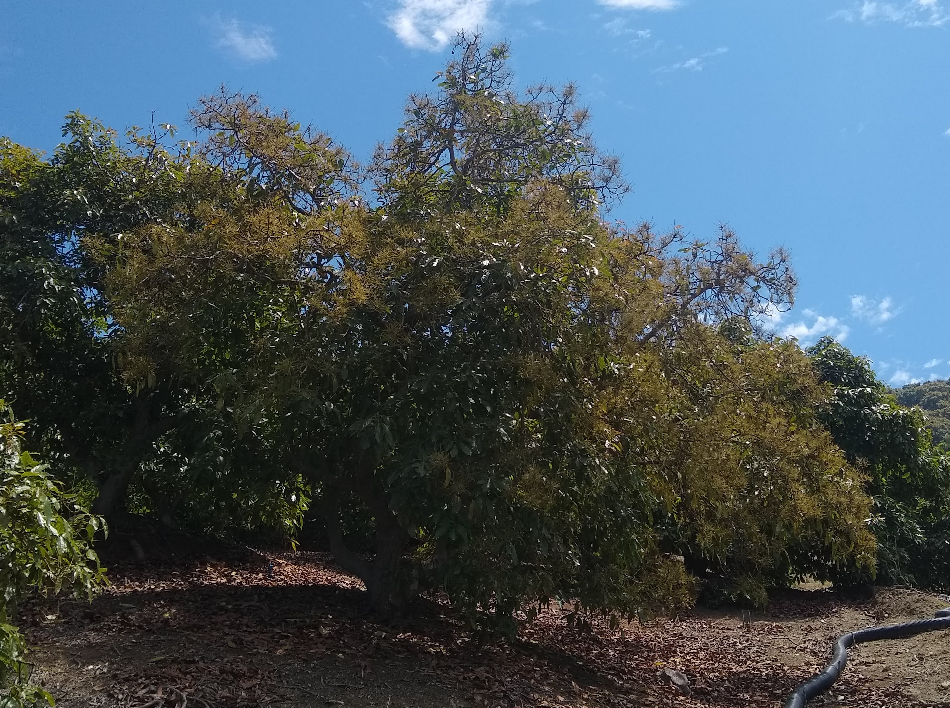

Growers in this area said that throughout May and June there was incessant fog. The flowers simply were not being visited by many honey bees because honey bees don’t like to fly in that weather, not to mention that the high rainfall had caused extra flowering among the surrounding native plants which are more attractive to many kinds of bees compared to avocado flowers.
On the other hand, a couple days ago, I saw groves of Hass trees at Cal Poly San Luis Obispo that had good fruitset, but Cal Poly is far enough inland to not be ensconced in fog like in Carpinteria.
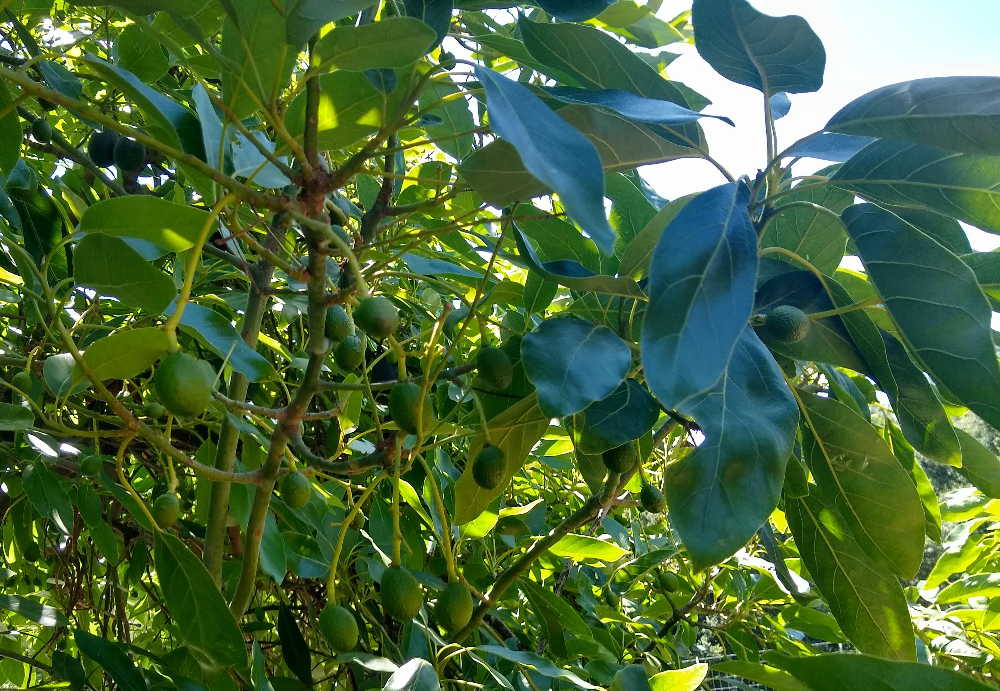
Girdling helped?
A farmer in Ventura County that I spoke to said his grove of Hass trees that is not too far inland has fine fruitset, and he thinks it’s because he girdles his trees and the girdling helps the flowers set fruit.
I’m inclined to believe him because my own Hass tree that I girdled also set a fine crop.
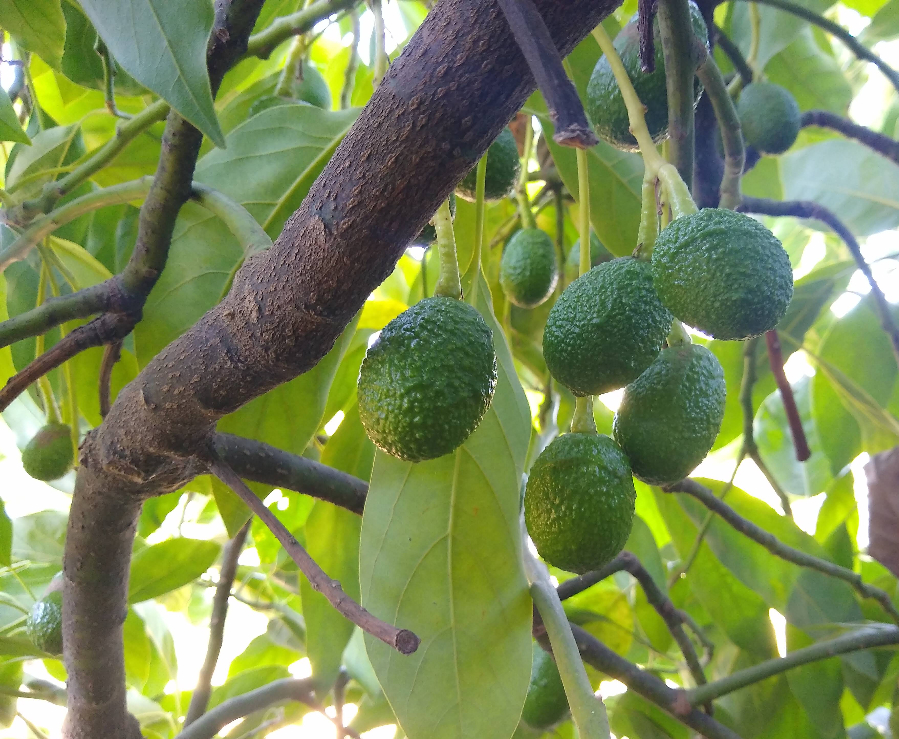
Honey bees overrated?
Each year during avocado bloom I take frequent walks among my trees to observe who is visiting the flowers. This year I saw almost no honey bees, but I did see various flies and some native bees on the avocado flowers. This observation worried me because it is a common belief that avocado flowers in California need visits from honey bees in order to be pollinated.
But this situation also gave me a chance to test the claim that honey bee visits are necessary for pollination. If my trees ended up with good fruitset despite the lack of visits by honey bees, then that common belief should be discarded; that is, honey bees are not necessary for good avocado pollination.
You already saw the good fruitset on my girdled Hass. I got good fruitset on most other varieties in my yard that had lots of flowers this spring too.
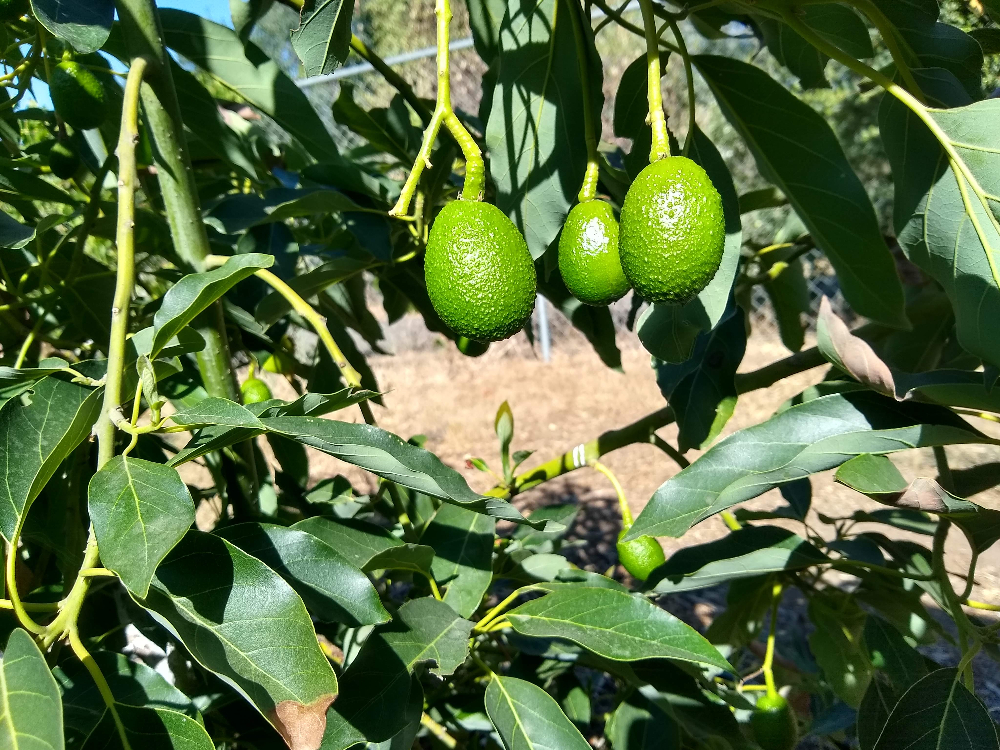
My conclusion: Honey bees are overrated as avocado pollinators. While they are good avocado pollinators, they are clearly not necessary, nor are they the only good avocado pollinator.
B types worse than A types?
Yet I do not have good fruitset on all of my trees. One of my Edranol trees flowered profusely.
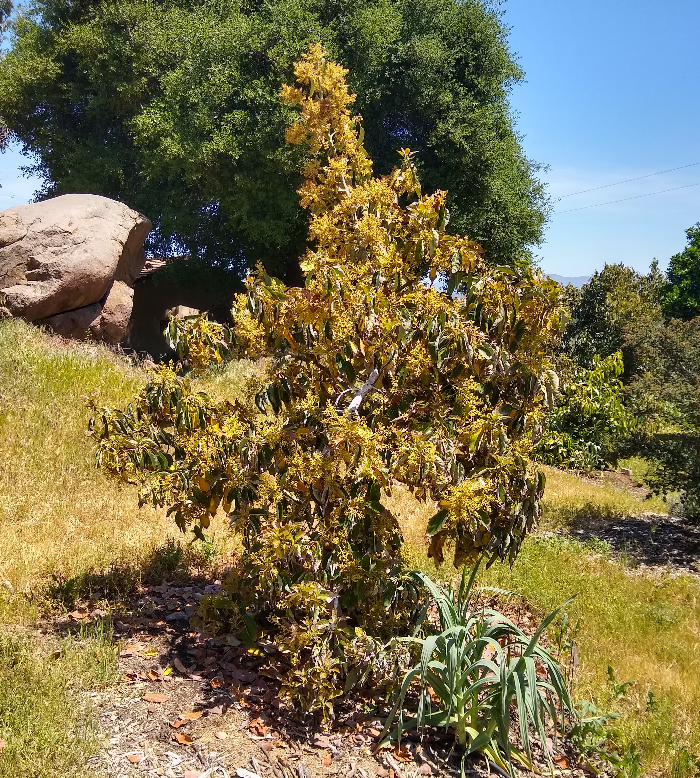
And yet today it has only a handful of young avocados growing on it.
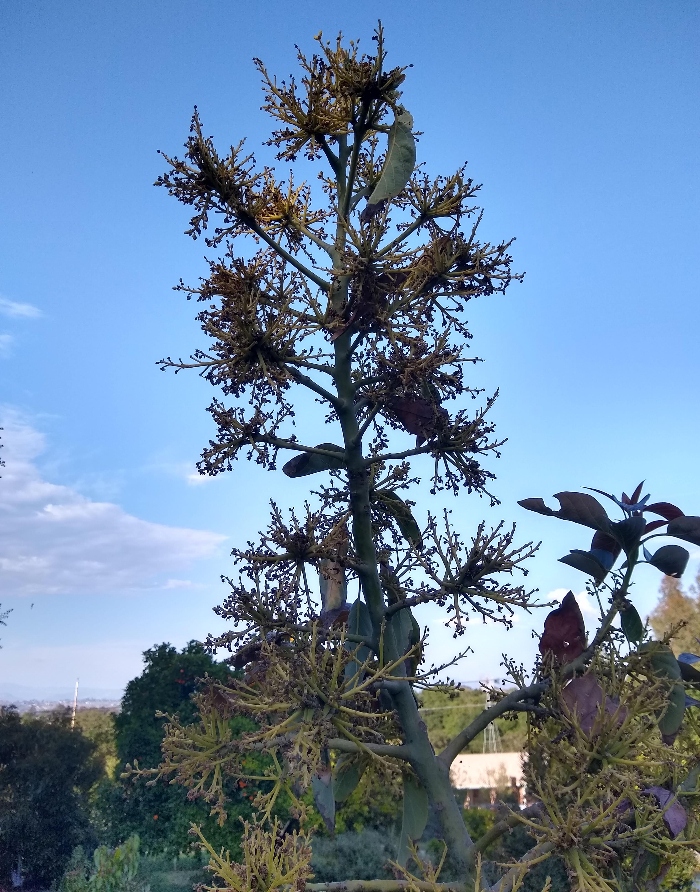
Edranol is an avocado variety with a B type flower, which means its flowers don’t function as well in cool weather compared to A-type varieties such as Hass and Gwen. That is my explanation.
In general, in my yard, the A types set fruit better than the B types, and I think this is because of the cool spring weather.
2023: rainy winter, chilly spring. How will the summer weather end up?
And how is the fruitset on your avocado trees? Can you explain the results? More ideas can be found in my post, “Why no avocados on your tree?”
You may have noticed that there are no ads on this website. That’s because I rely exclusively on your direct support to keep them up and coming. Thanks for all the support.
All of my Yard Posts are listed here.

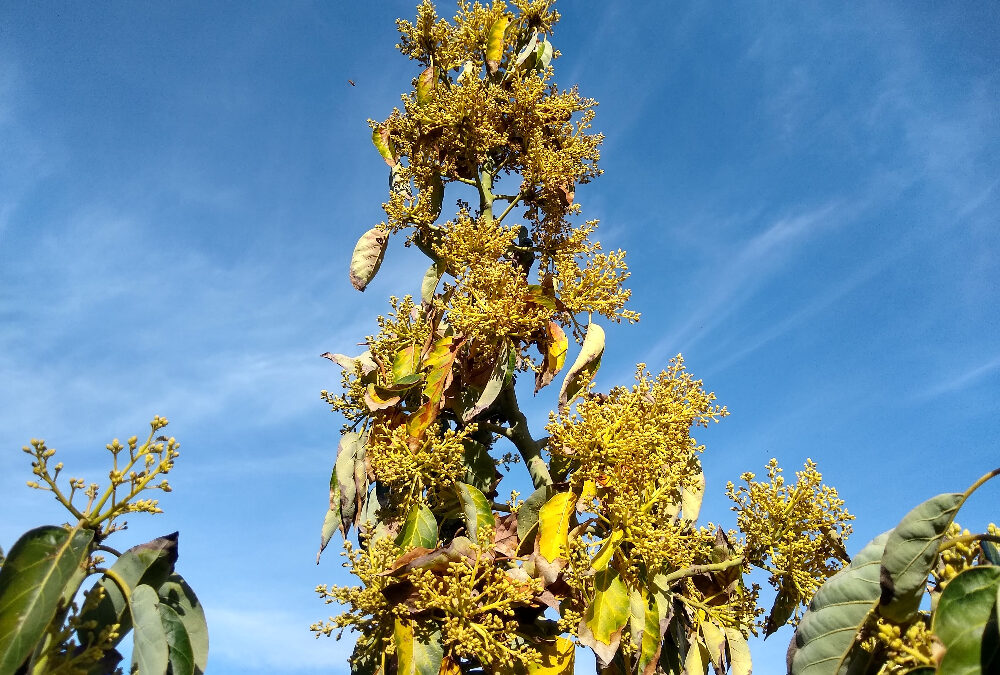


I live 2 miles from the Monterey Bay, and my two Hass trees didn’t set any fruit this year. 🙁
P.S.—Greg, What are your thoughts about why all of my other fruit trees (apples, pears, peaches, plums, citrus) have normal fruit set this year? Thanks!
Hi Olivia,
My other fruit trees all have normal crops too. My guess is that most of them were pollinated mostly by insects other than honey bees. Also, some of them are more easily pollinated at lower temperatures compared to avocados. And they don’t have the strange avocado flowering habit of opening as male or female at different times, thereby needing more visits by insects; they are “perfect” and have working male and female parts in every flower at all times. In short, they are all less finicky compared to avocados!
I live north of SDSU. All my avocado trees flowered nicely. My large Feurte set almost no fruit. I did not see any bees therefore I did multiple hand pollination of my large Hass tree which is a great producer. I hand pollinated using Feurte and Sirprize pollen and then because my b-type Cadway Cado had pollen after the others dropped their flowers I continued pollinating by hand. I think I’ve proven that the temperature and the sunshine are required for good pollination since the hundreds of flowers I pollinated only produced about 20 actual fruit set. I also hand pollinated a young Jan Boyce which has about 10 fruit sets. My eight other avocado trees will not produce much of anything this year. It was strange to see one or two bees buzzing around the avocado trees when in the past I’ve seen hundreds. What I noticed now is lots of bees attacking my pluots and peaches that have become overripe. I suppose the queen bee told the workers to get out there and don’t come back unless they have some sugar. Also, I hung some rotten bananas in a screen material bag in various places to increase the population of flies and gnats to help pollination. It is my conclusion that even after pollinating day after day with various types of pollen if the temperature is not correct the pollination will be unsuccessful.
Rick,
Your conclusion is supported by my experiences with hand pollinating. If it’s too cold, it just won’t happen.
By the way, I have good fruitset on my Cadway. Though it is a B type, it is in a warm spot of the yard beside a massive boulder that radiates heat. I think that helped it.
I live in Grover Beach a mile from the beach and for the second year in a row my tree flowered and set fruit in the spring and again in the fall. I have good size avocados and flowers with tiny avocado just starting to set. Two crops. Anyone else have this happen? I can’t explain it.
Hi Mitch,
Which variety of avocado tree do you have? This is common on the Carmen variety in some locations. It also can happen to a lesser degree on a few other varieties: Fuerte and Pinkerton, for example.
It’s a 60 year old hass that produces over 300 each year with a normal bloom. Last year it was closer to 500 with the double crop a few months apart and this year it looks like its going to be closer to 400. It’s a big hassle and I baby it by picking off dead leaves and branches, spraying with neem oil and feeding her 55 gallon barrels of compost tea. No store bought fertilizer. The compost tea is half a 5 gallon bucket of compost I make from blended kitchen scraps, I eat a lot of fruit and loquat, magnolia and hass avocado leaves from my yard that I mulch with a weed eater inside of a 55 gallon drum. A little epsom salt is the only other thing I feed her. When I moved here the tree was dying from root rot because the previous owner had old carpet under the tree and throughout the yard as an attempt to keep the weeds down. I just figured the tree is happy after I saved it.i have pictures of the flowers and new baby avocados and large bunches right behind them. Haven’t found another example of a hass doing this but I’ve only asked people I know that live around here and Santa Barbara.
We live in Orcutt, and have a hass tree, the avocados aren’t ripening, most are rubbery and others are brown, like wind scar. When can we pick them just right. Its almost December
Hi Matt,
See: https://gregalder.com/yardposts/when-to-pick-avocados/
Hi Greg. Thanks so much for all your wonderful information! One of my Hass trees is big now and it had tons of flowers this year in the northern San Fernando Valley. No fruitlets left, they all dropped off! I went ahead and bought a fuerte in case that helps it next season but it’s been too hot to plant it yet.
Hi Brenda,
Good idea. Cross-pollination opportunities can only help.
If you want, you can plant that Fuerte and just put some 30-50 percent shade over it for the next month or so. I often do that when I plant in summer because I have a hard time keeping potted plants watered.
Thank you, thank you! Will do!
Could you explain girdling a tree? Google told me it means removing a ring of bark to intentionally kill the tree, which doesn’t seem like what you meant.
Check out this post, Jessica: https://gregalder.com/yardposts/girdling-avocado-trees-for-consistent-fruiting/
In Santa Monica 2 miles from beach. Not one fruit. Bees are around but seem fewer.
I am in Boyle Heights in East LA, a good bit away from the beach and my avocado trees have lots of fruit.
I was so excited when I saw for the first time all these flowers on my Sir Prize but sadly no fruitlets developed. I live about 15 miles inland from the Monterey Bay.
Hi Laura,
I wonder if that’s because the tree is young or because it is a B type and wasn’t turning its flowers female in the chilly weather.
I was anxious to try a Sir Prize avocado when I saw two babies on the tree a couple years ago, but they both fell off. This year the tree was loaded with flowers and zero babies. I get the sense that it is a weak or sensitive variety. My Feurte is a weak producer also and I believe it’s my cooler location about 10 mi from the coast because those trees more inland produce well. I think when you combine a b-type that flowers in the morning and being in a cooler temperature zone along with early pollination in the season is why certain trees are poor producers. When all those flowers were gone my Nabal tree had just started producing flowers which gives it a better chance for warmer weather pollination.
I’m on a hill in Whittier, well away from the ocean and my 4 year old Pinkerton has 10 fruit, my 5 year old reed has about 25 fruit after some fell off, my two 5 year old hass have about 20 between them, lower than last year, my 2 5 year old bacon trees have zero, last year they had about 40 between the two. I also didn’t notice any honey bees in my yard during the prime pollination period as it was foggy and cool. I did see several very small bees and a few other blackish larger bees buzzing around still.
West Carson, My Haas is loaded, the fuerte has some but not a lot. Sir-prize too young to set anything but it bloomed.
1/4 mile from the coast in LA area, our old Fuerte had a the super bloom, and the bees showed up for a couple weeks. There was a only small crop- maybe 2 dozen, and after summer drop I’m left with less than 1 dozen. The other old tree had less flowering, minimal pollinators (I think they liked the other tree better) and I see one or two fruit way up high.
Big bloom, tiny fruit set here in Irvine. Prolonged cool spring. Maybe bees were hunkered down?
I live in Santa Barbara. If we walk to the beach, it’s about 3.5 miles. Just on the mountain side of 101 near Hwy 154. My 3 yr old Fuerte had ~60 fruit on it last year at this time, which I culled down to 35. I’ve not counted yet this year, but I think I’ll be lucky to get 20. On the other hand, I’ve picked ~120 fruit from my ~10 yr old Hass, and I’m sure there are 40 or so left still. This years crop looks even bigger, with multiple branches holding 10-20 fruit in clusters. My 3 yr old Reed yielded 7 avos that dropped in late May this year (very early, and not terribly tasty). The fruit set for next year is probably 30. I’ll likely cull that to 15 in a month or two once all the natural dropping occurs. Just moving around the branches a bit one fruit fell off.
So data from my yard supports A types yielding well, B types not so much. It was a VERY cool spring in our yard for sure.
I also posted a month or so ago on your blog about seeing flowers still on trees in Carpinteria in groves roughly a mile and a half from the beach near Carp HS. It would be interesting to go back and compare the fruit set on those trees to my Hass.
Thanks for that report, Matt. It sounds like 3.5 miles was far enough inland for good fruitset for you (assuming going inland helped during this spring). I didn’t look at trees near Carp high school. I’d like to know how their fruitset is. If it’s good, I’ll be surprised.
shoot, I was in the neighborhood of Carp HS this past weekend but failed to go check the fruitset. I do know my trees wouldn’t be doing so good if I didn’t have your guidance. Thanks so much Greg.
I’m about 3 miles inland in north county San Diego with a Hass (~8 y/o, planted a year ago) and Ettinger (~8 y/o planted ~2 years ago). Both trees had a huge bloom.
The Hass set ~130 fruit, which seemed to be too much for the tree’s size since it looked pretty stressed and wasn’t really growing a ton of leaves as of a few weeks ago. I pulled ~90% of the fruit off and the tree seems to be bouncing back.
The Ettinger set ~10 fruit but also looked pretty stressed and wasn’t really sprouting many new leaves as of a few weeks ago. After evaluating the situation I think I was watering too much. I’ve backed off the water and it’s dropped all but one fruit. Hoping the leaves start to fill in or I don’t think she’s going to make it…
Perhaps avocadoes do not need European honeybees for pollination since they are native to this hemisphere and are therefore in need of pollination from native bees. Almond trees (and all other common deciduous fruit and nut trees for that mater) are native to Europe and Asia and are therefore more effectively pollinated by the European honeybee.
Thanks, Joshua. That has always been my assumption too. I was pleased to see it possibly confirmed this spring.
I have read reports from some Israeli researchers who closely observed the insect visitors to avocado flowers in Mexico in the 1990’s, and one named Gad Ish-Am noted that at one grove the honeybees were not visiting the avocado flowers because they were more attracted to another plant flowering nearby “while up to 100 specimens per tree of Meliponinae and Brachygastra [native bee] species remained on the avocado flowers.” Later, Ish-Am saw that the pollination rate of those avocado flowers was very good, even better than the pollination rate that honeybees typically achieved in avocado groves in Israel.
So it seems plausible that we also have native bee species here in California that will pollinate avocado flowers well too.
Here is a comprehensive collection of research on avocado pollinators, in which I found Ish-Am’s report: https://www.researchgate.net/publication/278783400_Pollinators_of_Avocado
Well, this research could help avocado growers save money since I understand that the cost of bringing hives of European honeybees into their orchards — which has been a common practice — is considerable.
North Orange County avocado tree here … tons of flowers this spring, and tons of fruit that is still on my tree. I’ve picked a couple of avocados to see if they’ll ripen and they haven’t. So that means my fruit isn’t ready yet, right? In this past this tree (not sure type) fruited in January/February, so I’m confused by it having so much fruit on it in September. And also confused that it’s not “ready” yet.
Hi Amy,
Cool that you have tons of fruit this year!
Check out this post for help on picking: https://gregalder.com/yardposts/when-to-pick-avocados/
Hi Greg, My single Fuerte and single Reed did something very strange this year. Both trees are about 8 years old. Last year I was using every other month a 15-15-15 fertilizer. Not this year. This year I obtained from our local landfill free compost. I understand they use horse manure as the nitrogen component in the composting process. I also increased my watering according your chart. And I installed a sprinkler system. I past years I wasn’t watering enough.
The fuerte didn’t have hardly any blooms. The reed bloom was enormous. I only have 8 fruits on the reed. And zero on the fuerte. Both trees have grown more this year than all of the past 8 years. They have produced new leaves at an enormous rate and are still generating new growth. Over the top lush.
Both trees had an application of 2″ thick from the dump compost. And they get watered every 4-5 days. From the start when i planted both of these trees I followed your advice applying tons of compost every year.
Here in Mission Viejo our summer temperatures this year were kind to us . Not one single burnt leaf tip on both trees.
How can I correct the horrible fruit set. Oh, i had hundreds if not thousands of tiny fertilized blossoms on the reed, all fell off except 8! Yikes.
Every other plant I used that compost on grew like crazy.
Hi Ron,
Great to hear from you. And thanks for the interesting update on your trees.
I’m guessing that you will reap the rewards of your extra care and water next year. All of that growth should put out a healthy bloom in the spring since the trees aren’t carrying much/any fruit.
It’s hard to know why some trees drop a lot of blossoms or young fruit like your Reed. I have seen this happen many times and never feel sure as to why. There are so many possible causes.
One of my Edranol trees bloomed massively but set almost nothing this year. I think it was the cool temperatures, but I can’t say I’m sure about that. Even my Reed had a big bloom but only a moderate set. My only guess there is that it was because the Lamb next to it barely bloomed so it didn’t have the usual benefit of cross-pollination. The Lamb was healthy and had no crop, and so it should’ve bloomed a lot. Maybe it didn’t because it had a very big crop two years ago and was still somewhat in recovery.
You seem to be in the business and avocado smart. Seems most folks here are growers but as a consumer, I hope someone will have an answer.
Can you explain why there has not been any edible avocados in the grocery in the NE US for at least 6 months? We get unripe fruit that rot before ripening or fruit that is already rotten.
Was the crop devastated without anyone hearing about it?
Are the store buyers simply accepting garbage from their suppliers?
We pay a good price for avocados as expected for a crop that is not local, so it is utter disappointment to open a fruit to find it black yet still oddly hard or wait weeks only to have it never ripen or turn black.
And, yes, I am savvy on the ways to pick an avocado, just limited in choice by supply available.
Any information would be appreciated.
Thank you.
Hi Karen,
Your situation is so disappointing. I’d like to learn more. Have you noticed if the avocados available to you have all been from Mexico (or any other country)? Have you noticed stickers on them that say which packer or distributor they are from? Are they all the Hass variety?
Sad to say, but this kind of thing even happens to us here in Southern California during the fall and winter because the California avocado industry refuses to diversify and grow and sell varieties other than Hass (whose season is limited to spring and summer here). This is why so many who live here still grow their own avocados: the commercial avocado industry fails us.